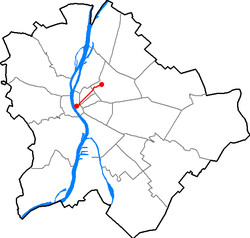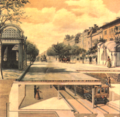- Line 1 (Budapest Metro)
-

Line 1 (Budapest Metro)Line number Line 1 ("Yellow metro") Technical Line length 4.4 km Track gauge 1435 mm Electrification 550 V DC Operating speed 60 km/h Route map Metro 1 

Vörösmarty tér 

Deák Ferenc tér - M2, M3 tr. 

Bajcsy-Zsilinszky út 

Opera 

Oktogon 

Vörösmarty utca 

Kodály körönd 

Bajza utca 

Hősök tere 

Széchenyi fürdő 

Mexikói út The Metro 1 (Officially: Millennium Underground Railway or M1) is the oldest line of the Budapest Metro system. Known in Budapest simply as "the underground" ("a földalatti"), it is the second oldest underground railway in the world (the first being the London Underground's Metropolitan Line), and the first on the European mainland. It was built from 1894 to 1896. In 2002, it was listed as a UNESCO World Heritage Site.[1]
Contents
History
This is one of the 3 metro lines in Budapest. The original purpose of the first metro line was to facilitate transport to Budapest City Park, although the capital always opposed any surface transport on Andrássy Avenue – this has since become one of the most elegant roads of Budapest, part of the World Heritage. The National Assembly accepted the metro plan in 1870 and the German firm Siemens & Halske AG was commissioned for the construction starting in 1894. It took 2000 workers using up-to-date machinery less than two years to complete it. This section was built entirely from the surface (with the cut-and-cover method). Completed by the deadline, it was inaugurated on May 2 1896, the year of the millennium (the thousandth anniversary of the arrival of the Magyars), by emperor Franz Joseph. One of these original cars is preserved at the Seashore Trolley Museum.
The train ran along Andrássy Avenue, from Vörösmarty Square (the centre) to City Park, in a northeast-southwest direction, but its terminus was the Zoo (this has since been replaced). It had eleven stations, nine underground and two overground. The length of the line was 3.7 km at that time; trains ran every two minutes. It was able to carry as many as 35,000 people a day (today 103,000 people travel on it on a workday).
- 1896: Gizella tér (today Vörösmarty tér) - Artézi fürdő (today Széchenyi fürdő)
- 1973: Széchenyi fürdő - Mexikói út
Stations and connections
Station Connection Buildings/Monuments Vörösmarty tér  2, 2A
2, 2AVigadó, Café Gerbeaud, Ministry of Finance Deák Ferenc tér  M2, M3
M2, M3
 9, 16, 105, 109
9, 16, 105, 109
 47, 49
47, 49Town Hall, Metro Museum (Földalatti Vasút Múzeum) Bajcsy-Zsilinszky út  105
105St. Stephen's Basilica Opera  105
105Hungarian State Opera House Oktogon  4, 6
4, 6
 105
105Theaters (Operette, Mikroszkóp, Miklós Radnóti,...) Vörösmarty utca  73, 76
73, 76House of Terror Kodály körönd  105
105Bajza utca  105
105Hősök tere  20E, 30, 30A, 105
20E, 30, 30A, 105
 75, 79
75, 79Museum of Fine Arts, Műcsarnok (Hall of Exhibitions), Városliget (City Park), Hősök tere (Heroes square) Széchényi fürdő  72
72Széchenyi thermal bath, Zoo and Botanical Garden, Vidámpark (Fun Fair) Mexikói út  3, 69
3, 69
 74, 74A
74, 74A
 25, 225, 32
25, 225, 32Gallery
-
Andrássy Avenue with the Millennium Underground (1896)
-
A train near the Hősök tere (before 1973)
References
Budapest Metro 





 Kőbánya-Kispest • Határ út • Pöttyös utca • Ecseri út • Népliget • Nagyvárad tér • Klinikák • Corvin-negyed • Kálvin tér • Ferenciek tere • Deák Ferenc tér • Arany János utca • Nyugati pályaudvar • Lehel tér • Dózsa György út • Árpád híd • Forgách utca • Gyöngyösi utca • Újpest-Városkapu • Újpest-Központ
Kőbánya-Kispest • Határ út • Pöttyös utca • Ecseri út • Népliget • Nagyvárad tér • Klinikák • Corvin-negyed • Kálvin tér • Ferenciek tere • Deák Ferenc tér • Arany János utca • Nyugati pályaudvar • Lehel tér • Dózsa György út • Árpád híd • Forgách utca • Gyöngyösi utca • Újpest-Városkapu • Újpest-Központ
 Under ConstructionKelenföldi pályaudvar • Tétényi út • Újbuda-Központ • Móricz Zsigmond körtér • Szent Gellért tér • Fővám tér • Kálvin tér • Rákóczi tér • Népszínház utca • Keleti pályaudvar
Under ConstructionKelenföldi pályaudvar • Tétényi út • Újbuda-Központ • Móricz Zsigmond körtér • Szent Gellért tér • Fővám tér • Kálvin tér • Rákóczi tér • Népszínház utca • Keleti pályaudvarSee also: BKV - HÉV - VEKE Categories:- Budapest Metro
- Railway lines opened in 1896
- World Heritage Sites in Hungary
Wikimedia Foundation. 2010.








